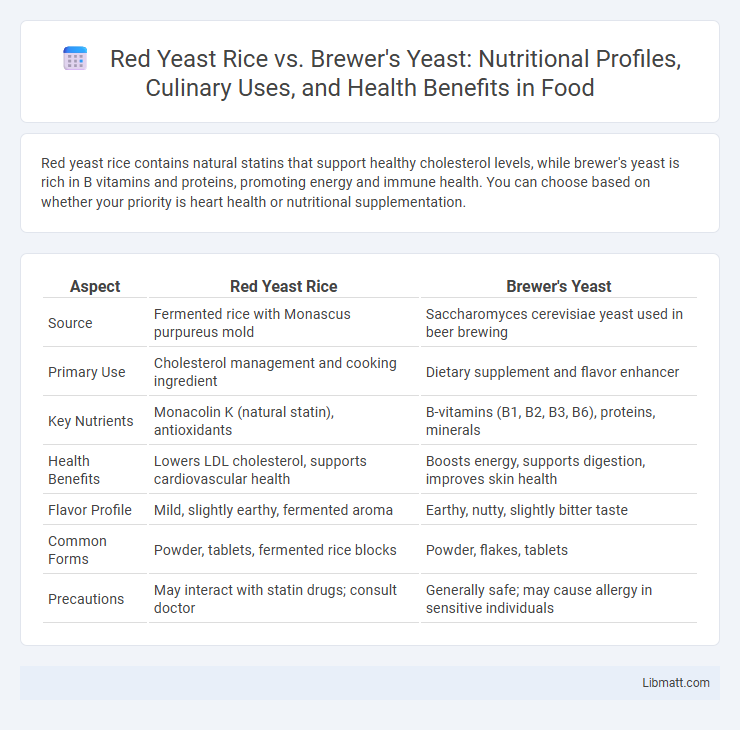Red yeast rice contains natural statins that support healthy cholesterol levels, while brewer's yeast is rich in B vitamins and proteins, promoting energy and immune health. You can choose based on whether your priority is heart health or nutritional supplementation.
Table of Comparison
| Aspect | Red Yeast Rice | Brewer's Yeast |
|---|---|---|
| Source | Fermented rice with Monascus purpureus mold | Saccharomyces cerevisiae yeast used in beer brewing |
| Primary Use | Cholesterol management and cooking ingredient | Dietary supplement and flavor enhancer |
| Key Nutrients | Monacolin K (natural statin), antioxidants | B-vitamins (B1, B2, B3, B6), proteins, minerals |
| Health Benefits | Lowers LDL cholesterol, supports cardiovascular health | Boosts energy, supports digestion, improves skin health |
| Flavor Profile | Mild, slightly earthy, fermented aroma | Earthy, nutty, slightly bitter taste |
| Common Forms | Powder, tablets, fermented rice blocks | Powder, flakes, tablets |
| Precautions | May interact with statin drugs; consult doctor | Generally safe; may cause allergy in sensitive individuals |
Introduction to Red Yeast Rice and Brewer’s Yeast
Red Yeast Rice is a fermented rice product infused with red mold Monascus purpureus, known for its natural compounds that support healthy cholesterol levels. Brewer's Yeast, a byproduct of beer brewing from Saccharomyces cerevisiae, is rich in B vitamins, protein, and minerals that promote overall health and digestion. Understanding the distinct nutritional profiles of each can help you choose the right supplement for your dietary needs.
Origins and Production Methods
Red yeast rice originates from fermenting rice with the Monascus purpureus mold, traditionally used in Chinese cuisine and medicine, while brewer's yeast is a byproduct of beer brewing, derived from Saccharomyces cerevisiae. The production of red yeast rice involves controlled fermentation of rice, allowing the mold to produce natural compounds like monacolin K, known for cholesterol-lowering effects. Brewer's yeast is harvested after fermentation of barley or other grains in beer production, rich in B vitamins and proteins, commonly used as a dietary supplement.
Nutritional Profiles Compared
Red yeast rice contains monacolin K, a compound similar to lovastatin, which supports cholesterol management, whereas brewer's yeast is rich in B vitamins, chromium, and protein, enhancing energy metabolism and blood sugar control. Both supplements offer distinct nutritional benefits: red yeast rice is primarily valued for cardiovascular health, while brewer's yeast provides broad-spectrum nutrients beneficial for immune function and skin health. When choosing between them, consider your health goals and consult your healthcare provider to determine which yeast aligns best with your dietary needs.
Key Active Compounds
Red yeast rice contains monacolin K, a potent statin compound that effectively lowers LDL cholesterol by inhibiting HMG-CoA reductase. Brewer's yeast is rich in B-complex vitamins, chromium, and beta-glucans, which support metabolism and immune function rather than directly impacting cholesterol levels. The distinct active compounds in red yeast rice and brewer's yeast determine their differing roles in cardiovascular health and nutritional supplementation.
Health Benefits of Red Yeast Rice
Red Yeast Rice contains naturally occurring monacolin K, which is known to support healthy cholesterol levels and promote cardiovascular health. Its antioxidant properties help reduce inflammation and improve lipid profiles, making it a popular supplement for managing heart health. If you aim to enhance your heart health, incorporating Red Yeast Rice into your routine may provide significant benefits.
Health Benefits of Brewer’s Yeast
Brewer's yeast is rich in B-complex vitamins, protein, and minerals like chromium and selenium, supporting energy production and metabolic health. It helps regulate blood sugar levels and improves digestive health by promoting beneficial gut bacteria. Incorporating brewer's yeast into your diet can enhance immune function and provide antioxidants to combat oxidative stress.
Potential Side Effects and Risks
Red Yeast Rice may cause muscle pain, liver damage, and digestive issues due to its naturally occurring statin compounds, and it can interact with cholesterol-lowering medications. Brewer's Yeast is generally safe but may trigger allergic reactions, digestive upset, and headaches in sensitive individuals, especially those with yeast allergies or compromised immune systems. Monitor your health closely when taking either supplement, and consult your healthcare provider to avoid adverse effects and interactions.
Usage in Supplements and Food Products
Red Yeast Rice is commonly used in dietary supplements for its natural statin compounds that support healthy cholesterol levels, while Brewer's Yeast is frequently incorporated into food products and supplements as a rich source of B-vitamins, protein, and probiotics. Your choice between these yeasts depends on whether you seek cardiovascular benefits or nutritional supplementation, particularly for energy metabolism and digestive health. Both are valued in functional foods and nutraceuticals, but Red Yeast Rice is more targeted for lipid management, whereas Brewer's Yeast enhances nutritional profiles and gut flora.
Scientific Evidence and Clinical Studies
Red yeast rice contains monacolin K, a compound chemically identical to the cholesterol-lowering drug lovastatin, supported by numerous clinical studies demonstrating its effectiveness in reducing LDL cholesterol levels. Brewer's yeast, rich in B vitamins and proteins, has been less extensively studied for cardiovascular benefits but shows potential in improving blood sugar regulation and supporting gut health according to emerging research. Scientific evidence positions red yeast rice as a more potent agent for lipid management, while brewer's yeast is valued for its nutritional support and metabolic effects.
Choosing the Right Yeast for Your Health
Red yeast rice contains natural statins that may help lower cholesterol, making it suitable for those focused on cardiovascular health, while brewer's yeast is rich in B vitamins, protein, and minerals, supporting energy metabolism and immune function. Your choice depends on specific health goals: red yeast rice is often preferred for cholesterol management, whereas brewer's yeast supports overall nutritional balance and digestion. Understanding these key differences ensures you select the yeast that best aligns with your personal wellness needs.
Red Yeast Rice vs Brewer’s Yeast Infographic

 libmatt.com
libmatt.com